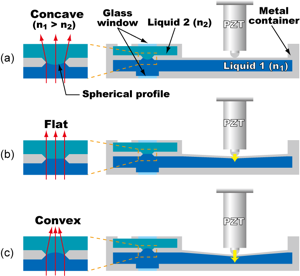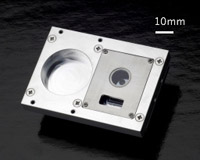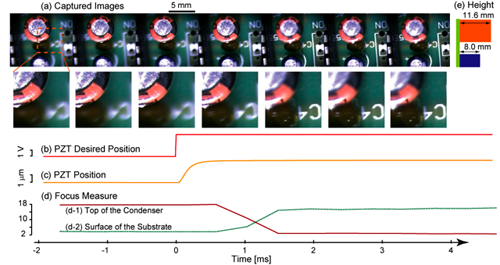Dynamorph Lens (DML): A High-Speed Liquid Lens with High Resolution
Summary
High-speed focusing technology has been desired for decades. The focusing speed of conventional optical systems is limited by the slow response time involved with the physical actuation of lenses. One possible solution is to develop variable-focus devices. Production of practical focusing devices with both high response speed and high optical performance is, however, still a challenge. A liquid interface is known to be suitable for the surface of such a lens due to its almost perfect spherical shape and deformability. Therefore, liquid lenses show great potential to realize both high-speed focusing and high optical performance.
We developed a liquid lens using a liquid-liquid interface that can arbitrarily control the focal length in milliseconds and achieve practical imaging performance. This lens dynamically changes the curvature of the interface by means of liquid pressure, as shown in Fig. 1. Two immiscible liquids, indicated as liquids 1 and 2, are infused in two chambers, but they are interfaced at a circular hole that works as an aperture of the lens. This interface works as a refractive surface due to the different refractive indices of the two liquids. One chamber (the lower chamber in Fig. 1) is equipped with a deformable wall that a piezostack actuator thrusts to change the chamber volume. When the piezostack actuator extends, the lower chamber volume decreases, and the surplus liquid volume presses the interface to change its shape from convex to concave. Since this lens morphs its interface dynamically, it is called a Dynamorph Lens.
Based on the above design, a prototype with an aperture diameter of 3.0 mm was developed. Its photograph is shown in Fig. 1 (a). Ultrapure water and polydimethyl-siloxane (PDMS) were used as immiscible liquids. A wide refractive power change of about 52 D was achieved with a displacement of only 12 um. Note that the initial refractive power could be adjusted by altering the infused volume of liquid 1. The response time of the prototype was measured to be about 2 ms by capturing high-speed video through the prototype while switching its focal length every 10 ms. Image sequences and input/output signals are shown in Fig. 2. Movies of the prototype and the images captured by the high-speed video are also shown in the below.

|

|
|
Figure 1. A photograph of the prototype (a), and cross-sectional view of the Dynamorph lens to illustrate its focusing mechanism (b)-(d). |
|
|---|---|

|
| Figure 2. Step response of the prototype. Top image sequence was captured at 2200 fps through the prototype (a). The voltage input to the actuator (b) and the resulting position (c) are shown below. Focus measures of two regions, the top of the capacitor and the substrate, were extracted from the captured images (d). The capacitor was 11.6 mm in height (e). |
|---|
Movies
A movie of the prototype
A 0.01 slow-motion movie of the focus switching
References
- Hiromasa Oku and Masatoshi Ishikawa : High-Speed Liquid lens for Computer Vision, 2010 IEEE International Conference on Robotics and Automation (ICRA 2010) (Anchorage, 2010.5.5) / Conference Proceedings, pp.2643-2648 [PDF (1.6MB)]*IEEE
- Hiromasa Oku and Masatoshi Ishikawa : High-speed liquid lens with 2-ms response and 80.3-nm root-mean-square wavefront error, SPIE Photonics West 2010 (San Francisco, 2010.1.25) / Proceedings, 7594-05 (Oral Session) [PDF (2.1MB)]
- Hiromasa Oku and Masatoshi Ishikawa : High-speed liquid lens with 2 ms response and 80.3 nm root-mean-square wavefront error, Applied Physics Letters, Vol.94, 221108 (2009) [PDF (312K)] [doi:10.1063/1.3143624] *AIP
- Hiromasa Oku, Masatoshi Ishikawa : Rapid Liquid Variable-Focus Lens with 2-ms Response, 19th Annual Meeting of the IEEE Lasers & Electro-Optics Society (Montreal, 2006.11.2)/Proceedings pp.947-948 [PDF (527K)] *IEEE
*AIP © 2009 American Institute of Physics. This article may be downloaded for personal use only. Any other use requires prior permission of the author and the American Institute of Physics. The article appeared in H. Oku et al.,Appl. Phys. Lett. 94, 221108 (2009) and may be found at http://link.aip.org/link/?APL/94/221108.
*IEEE © 2006-2010 IEEE. Personal use of this material is permitted. However, permission to reprint/republish this material for advertising or promotional purposes or for creating new collective works for resale or redistribution to servers or lists, or to reuse any copyrighted component of this work in other works must be obtained from the IEEE.



